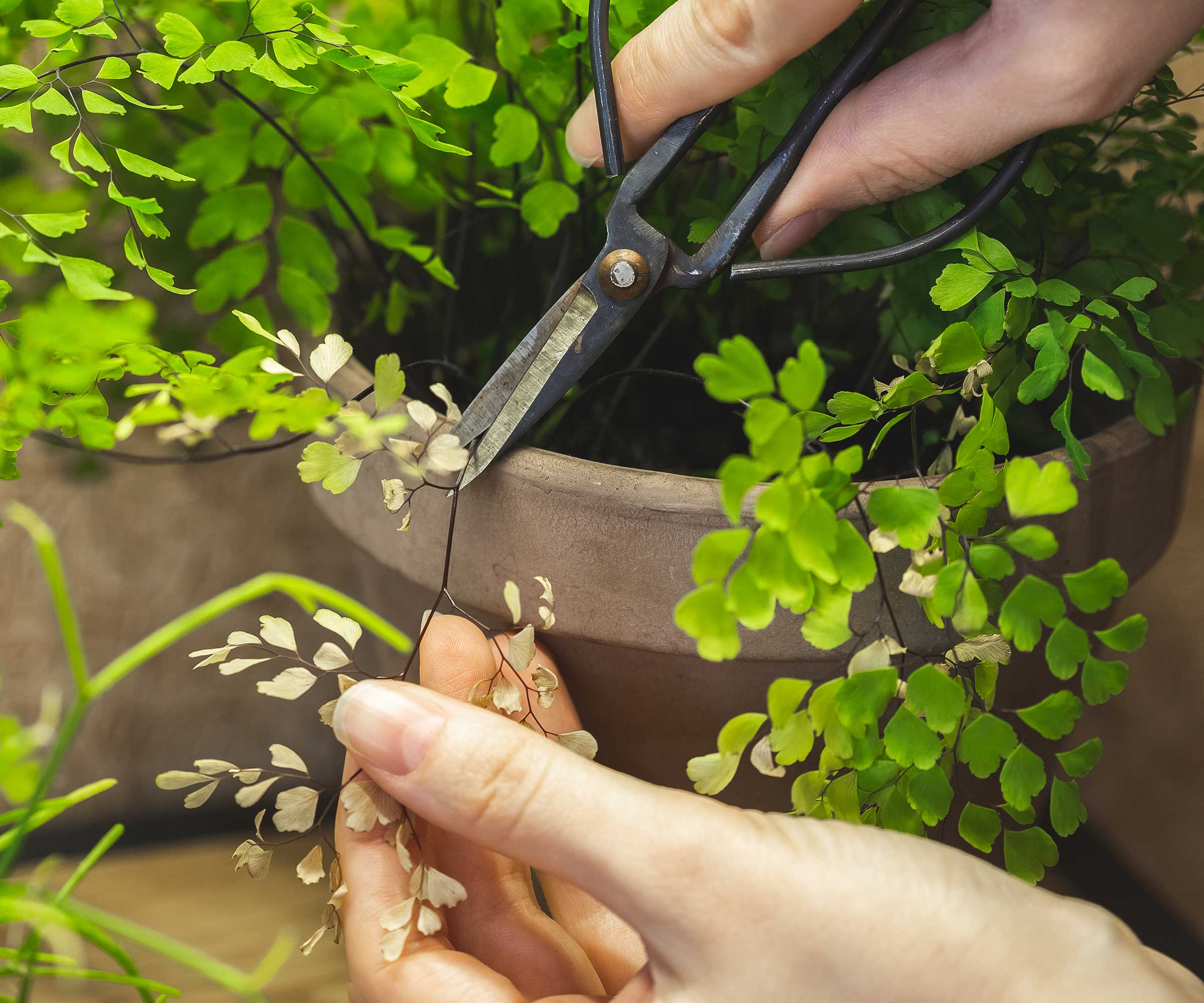How to care for a maidenhair fern – plant pros share top tips for these delicate beauties
Keep your maidenhair fern looking its best with this advice on watering, sunlight, pruning, and more


Q: I recently bought a maidenhair fern for my home as I was drawn to its intricate foliage. I'm not sure how to care for it – do you have any advice?
A: Maidenhair ferns, or Adiantum, make beautiful houseplants and are one of my personal favorites. They have a reputation for being tricky to look after, but don't let that put you off. With the right know-how, you can help yours thrive and keep its delicate leaves luscious and green.
Below, houseplant experts share all the essentials for caring for these indoor ferns, including key advice on their watering needs. There are also tips on propagating them, if you fancy expanding your collection for free.

Maidenhair ferns are popular for their small, fan-shaped leaves
3 essential tips for caring for a maidenhair fern
Keep these fabulous indoor plants looking gorgeous in your home with the following advice.
1. Keep the soil moist

Don't let these ferns dry out
Amy Enfield, senior horticulturist at ScottsMiracle-Gro, says maidenhair ferns prefer their soil to be consistently moist, but not soggy. Too little or too much water could cause a drooping fern. She recommends watering them thoroughly when the top inch of the soil feels slightly dry, using distilled water or rainwater if possible, as these ferns are sensitive to the chemicals in tap water. 'They should always be watered with room-temperature water,' she adds.
Nastya Vasylchyshyna, a resident botany expert at Plantum, highlights the importance of using a container with drainage holes at the bottom. 'This way, you'll avoid soggy soil and prevent root rot,' she says.
Top tip: Diane Kuthy of How To Grow Everything recommends investing in watering globes for these indoor plants. 'If their soil dries out even a little bit, their delicate fronds will die back seemingly overnight,' she warns.
Design expertise in your inbox – from inspiring decorating ideas and beautiful celebrity homes to practical gardening advice and shopping round-ups.
As well as moist soil, these plants thrive in humidity. This is why they do well in terrariums, as Amy highlights.
Diane found that keeping her maidenhair fern as a bathroom plant provided enough moisture in the air to keep it happy. However, you could also place the pot on a water-filled tray with pebbles or near a humidifier, notes Amy. We like the look of this well-rated 2.5-liter Levoit humidifier from Amazon.

Amy has over 25 years of experience in the lawn and garden industry and has been with ScottsMiracle-Gro for 11 years. She has a BS and MS in Horticulture from Michigan State University and a PhD in Plant and Environmental Sciences from Clemson University.

Nastya is a professional botany expert for the Plantum app that helps identify plants and plant diseases and provides care recommendations. Her specialization is plant morphology, phytopathology, and plant physiology.

Diane Kuthy is the founder and lead plant expert at How To Grow Everything, a collection of comprehensive grow guides for every plant and vegetable. Diane has over 10 years of gardening experience and she currently manages a 5-acre farm, a four-season greenhouse, over 50 perennial fruit and vegetable varieties, and a large indoor plant conservatory.
2. Avoid direct sunshine

Bright, indirect light is best
Diane recommends keeping maidenhair ferns in a sunny room, but out of direct, intense sunlight, as this can scorch their delicate fronds.
According to Amy, they will tolerate lower light conditions, but this will make them grow more slowly. 'If the light conditions are too low, their fronds may start to yellow,' she adds.
Kayla Gajdascz, the owner of Mental Houseplants, says, 'An east- or north-facing window is ideal. If natural light is insufficient, grow lights can supplement.'
On the topic of location, don't forget to protect your houseplants from central heating, as well as drafts and air conditioning, as Kayla points out. 'Keep the temperature between 60–75° Fahrenheit.'
This clever Govee Bluetooth thermometer from Amazon measures temperature as well as humidity levels, making it easier to get the surroundings just right for your plant pals.

Kayla is the owner and co-founder of Mental Houseplants, an online plant retailer that sells a unique selection of houseplants to promote mental health awareness that is complemented by expert care tips and resources. Mental Houseplants further strengthens mental health support by partnering with and donating to the National Alliance on Mental Illness with each sale.
3. Prune yellowing leaves

Tidy up your fern by trimming away old stems
Amy says you can remove dead or yellowing fronds to encourage new growth and maintain the plant's appearance. 'The entire frond should be removed near the plant’s crown,' she advises.
Be sure to handle the plant with care, Kayla adds. 'The fronds are delicate and can be damaged easily.'
FAQs
Can you propagate maidenhair ferns?
There are a couple of ways to propagate these houseplants. The simplest technique is by division. To do so, Kayla says to carefully remove the fern from its pot, then gently separate the rootball into smaller sections, ensuring each section has healthy roots and fronds. 'Plant each section in its own pot with fresh, well-draining soil,' she continues. 'Water thoroughly and keep in a humid environment until established.'
Nastya recommends doing this in spring or summer when you go to repot your houseplant. You can also do it when you bring the plant home from the store and plant it in a fresh growing medium, she adds.
Alternatively, you can propagate maidenhair ferns by spores. However, bear in mind that this is more challenging, and you'll need to have patience, as Amy points out. What's more, this method can only be done if your fern is producing sori (spore clusters) – the brown clusters on the underside of the fronds, she says.
'Remove the frond and place it in a paper envelope until it dries and the spores fall off,' Amy instructs. 'Then, fill a tray with damp potting mix, sprinkle the spores on top, and cover the tray with plastic wrap.' The tray needs to be kept in a warm spot out of direct sunlight, she adds.
What pests can be a problem for maidenhair ferns?
Amy says, 'Indoor-grown maidenhair ferns are fairly pest free, but can be susceptible to aphids, scale, mealybugs, and spider mites. Regularly inspect your plants and treat any infestations promptly.'
Both Amy and Kayla recommend using insecticidal soap to tackle interlopers. The Garden Safe ready-to-use spray from Amazon has great reviews.
Alternatively, you could use neem oil, Kayla adds.
If you're looking for more pretty plants to enhance the jungle vibe in your home, why not invest in an equally elegant asparagus fern or the popular Boston fern? Our handy guides will help you care for them.

Holly started writing about gardening five years ago, and she is a regular contributor to Homes & Gardens. She has also written many gardening features for Woman & Home and Real Homes, too. She has previous experience as a professional gardener, where she helped to plant and maintain private gardens. Holly has also looked after allotment plots over the years and loves to grow her own flowers and veggies from seed. In her spare time, she enjoys visiting local gardens, botanical drawing, and tending to her ever-growing collection of houseplants.